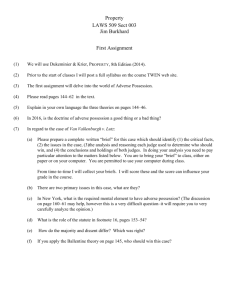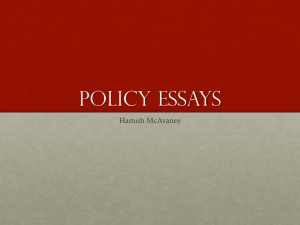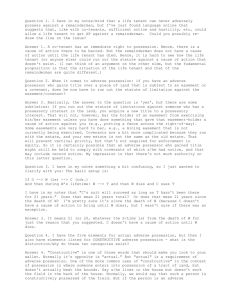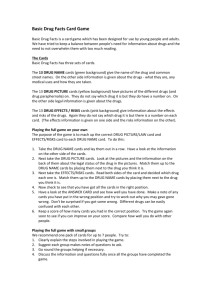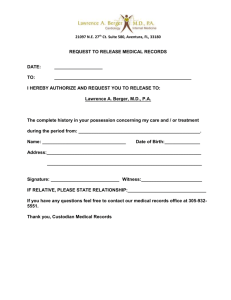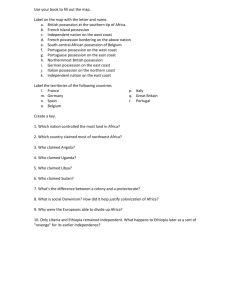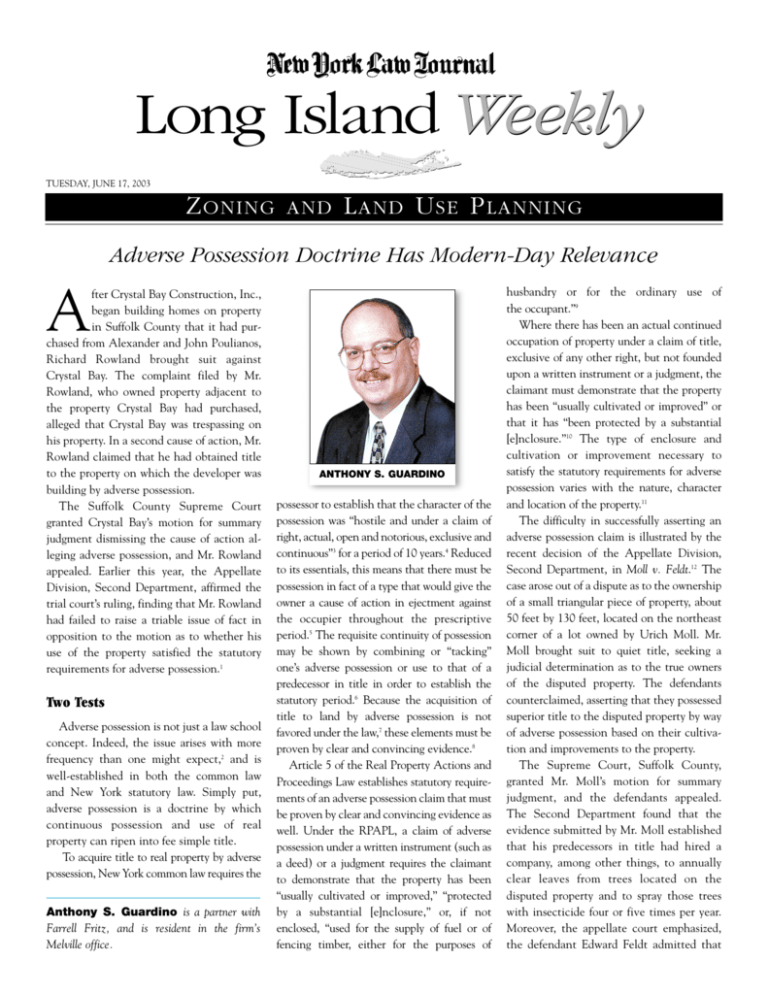
Long Island Weekly
TUESDAY, JUNE 17, 2003
Z ONING
AND
L AND U SE P LANNING
Adverse Possession Doctrine Has Modern-Day Relevance
A
fter Crystal Bay Construction, Inc.,
began building homes on property
in Suffolk County that it had purchased from Alexander and John Poulianos,
Richard Rowland brought suit against
Crystal Bay. The complaint filed by Mr.
Rowland, who owned property adjacent to
the property Crystal Bay had purchased,
alleged that Crystal Bay was trespassing on
his property. In a second cause of action, Mr.
Rowland claimed that he had obtained title
to the property on which the developer was
building by adverse possession.
The Suffolk County Supreme Court
granted Crystal Bay’s motion for summary
judgment dismissing the cause of action alleging adverse possession, and Mr. Rowland
appealed. Earlier this year, the Appellate
Division, Second Department, affirmed the
trial court’s ruling, finding that Mr. Rowland
had failed to raise a triable issue of fact in
opposition to the motion as to whether his
use of the property satisfied the statutory
requirements for adverse possession.1
Two Tests
Adverse possession is not just a law school
concept. Indeed, the issue arises with more
frequency than one might expect,2 and is
well-established in both the common law
and New York statutory law. Simply put,
adverse possession is a doctrine by which
continuous possession and use of real
property can ripen into fee simple title.
To acquire title to real property by adverse
possession, New York common law requires the
Anthony S. Guardino is a partner with
Farrell Fritz, and is resident in the firm’s
Melville office.
ANTHONY S. GUARDINO
possessor to establish that the character of the
possession was “hostile and under a claim of
right, actual, open and notorious, exclusive and
continuous”3 for a period of 10 years.4 Reduced
to its essentials, this means that there must be
possession in fact of a type that would give the
owner a cause of action in ejectment against
the occupier throughout the prescriptive
period.5 The requisite continuity of possession
may be shown by combining or “tacking”
one’s adverse possession or use to that of a
predecessor in title in order to establish the
statutory period.6 Because the acquisition of
title to land by adverse possession is not
favored under the law,7 these elements must be
proven by clear and convincing evidence.8
Article 5 of the Real Property Actions and
Proceedings Law establishes statutory requirements of an adverse possession claim that must
be proven by clear and convincing evidence as
well. Under the RPAPL, a claim of adverse
possession under a written instrument (such as
a deed) or a judgment requires the claimant
to demonstrate that the property has been
“usually cultivated or improved,” “protected
by a substantial [e]nclosure,” or, if not
enclosed, “used for the supply of fuel or of
fencing timber, either for the purposes of
husbandry or for the ordinary use of
the occupant.”9
Where there has been an actual continued
occupation of property under a claim of title,
exclusive of any other right, but not founded
upon a written instrument or a judgment, the
claimant must demonstrate that the property
has been “usually cultivated or improved” or
that it has “been protected by a substantial
[e]nclosure.”10 The type of enclosure and
cultivation or improvement necessary to
satisfy the statutory requirements for adverse
possession varies with the nature, character
and location of the property.11
The difficulty in successfully asserting an
adverse possession claim is illustrated by the
recent decision of the Appellate Division,
Second Department, in Moll v. Feldt.12 The
case arose out of a dispute as to the ownership
of a small triangular piece of property, about
50 feet by 130 feet, located on the northeast
corner of a lot owned by Urich Moll. Mr.
Moll brought suit to quiet title, seeking a
judicial determination as to the true owners
of the disputed property. The defendants
counterclaimed, asserting that they possessed
superior title to the disputed property by way
of adverse possession based on their cultivation and improvements to the property.
The Supreme Court, Suffolk County,
granted Mr. Moll’s motion for summary
judgment, and the defendants appealed.
The Second Department found that the
evidence submitted by Mr. Moll established
that his predecessors in title had hired a
company, among other things, to annually
clear leaves from trees located on the
disputed property and to spray those trees
with insecticide four or five times per year.
Moreover, the appellate court emphasized,
the defendant Edward Feldt admitted that
NEW YORK LAW JOURNAL
there were no fences anywhere on his
property. Thus, the Appellate Division
found, the defendants’ possession of the disputed property was not exclusive as required
for title to pass by adverse possession.
The Second Department concluded that
“[t]he evidence of the defendants’ cultivation of
and improvements to the disputed property,
even taken together with the statements by
the defendant Edward Feldt to the effect that
he never observed [Mr. Moll’s] predecessors
in title perform any maintenance on the
disputed property, were insufficient to
demonstrate the existence of a triable issue of
fact as to the exclusivity of the defendants’
possession of the disputed property.”
The Government Exception
As a general rule, a municipality cannot
lose title through adverse possession to
property that it owns in its governmental
capacity, or that has been made inalienable by
statute.13 However, when a local government
holds real property in its proprietary capacity,
there is no immunity against adverse
possession.14 The recent Second Department
decision in Monthie v. Boyle Road Associates,
L.L.C.15 focuses on this distinction.
The case arose after the Comsewoque
School District acquired title in fee simple to a
parcel of land consisting of 48 acres in the
Town of Brookhaven sometime in the late
1960s. The parcel was bordered by Boyle Road.
Subsequently, the school district built the
Boyle Road Elementary School on the site.
The school buildings, playground and athletic
fields used only 19 acres, with the remaining 29
acres remaining undeveloped and consisting
primarily of shrubs and second-growth trees.
In 1986, the school district offered to sell
the 29-acre parcel. The notice described the
site as “real property known as vacant land at
the Boyle Road School site,” and declared
that the land was zoned “Residential-B1.”
The offer also stated that the board of education was “offering to sell … vacant land which
[is] no longer required for school purposes.”
The district did not sell the property until
Aug. 20, 1998, when Boyle Road Associates
L.L.C. acquired title. Apparently, the 29-acre
parcel remained in its natural state from
its original offering in 1986 until 1998.
Additionally, although the 29 acres were not
TUESDAY, JUNE 17, 2003
partitioned or otherwise subdivided from the
19 acres devoted to the elementary school,
the district installed and maintained a
cyclone fence that partially separated the
school’s playing fields from the wooded
acreage sometime prior to 1983.
Following Boyle Road Associates’ acquisition of the 29 acres, it was discovered
that several homeowners with properties
contiguous to the 29 acres had been using
portions of the property for many years.
A number of homeowners brought suit
against Boyle Road Associates, alleging that
they had acquired title to the disputed
portions of the property by adverse possession. Boyle Road Associates moved for
------------------------------------------------
Adverse possession
is not just a law school
concept. Indeed, the issue
arises with more frequency
than one might expect, and is
well-established in both the
common law and New York
statutory law.
------------------------------------------------
summary judgment.
Suffolk County Supreme Court began its
analysis by stating that, as a matter of law, a
municipal corporation cannot lose title to real
property through adverse possession when the
land is held in a governmental capacity. The
court continued by noting that a municipality
can, however, lose property by adverse possession when the land is held for a proprietary
purpose rather than a governmental one.
The court concluded that an issue of fact
existed as to whether the 29-acre parcel actually was held in a proprietary capacity that would
serve to give validity to the plaintiffs’ claim of
adverse possession. The court found that there
was no evidence that the parcel had been held
in a governmental capacity since 1971, and it
specifically noted that in listing the property
for sale, the school district had referred to the
29-acre parcel as the “Boyle Road Residential
Site” and had indicated that this vacant land
was “no longer required for school purposes.”
Boyle Road Associates appealed.
The Second Department affirmed, upholding the trial court’s decision that there were
issues of fact as to whether the 29-acre parcel
retained its governmental character even
after the school district had concluded that
the property was no longer necessary for a
governmental purpose. The Second Department emphasized that it was uncontroverted
that the parcel had remained in the same
undeveloped condition from the time the
school district had purchased the land until its
sale in 1998, and that the school district had
taken affirmative action by conducting a
district-wide referendum to sever that portion
that was no longer needed for school
purposes so that it could be sold.
Conclusion
Numerous legal issues can arise in adverse
possession disputes, from whether a tenant
has the capacity to adversely possess land belonging to someone other than his or her
landlord (such as an adjoining landowner)16 to
the type of “cultivation” or “improvement”
sufficient to satisfy the RPAPL’s requirements.17 Although not a frequent claim,
adverse possession can present complicated
factual questions as well.
••••••••••••••
•••••••••••••••••
(1) Rowland v. Crystal Bay Construction, Inc., 301 A.D.2d 585
(2d Dept. 2003).
(2) Recently reported decisions in Long Island cases involving claims of adverse possession include: Oak Ponds, LLC v.
Willumsen, 295 A.D.2d 587 (2d Dept. 2002); Moll v. Feldt, 289
A.D.2d 462 (2d Dept. 2001); Matter of Incorporated Village of
Garden City v. Cathedral of the Incarnation in the Diocese of Long
Island, 289 A.D.2d 406 (2d Dept. 2001); Gold v. Hui-Yin Huang,
285 A.D.2d 580 (2d Dept. 2001); Monthie v. Boyle Road Associates, L.L.C., 281 A.D.2d 15 (2d Dept. 2001). For discussions of
the law of adverse possession by the New York Court of Appeals,
see, e.g., Myers v. Bartholomew, 91 N.Y.2d 630 (1998); Ray v.
Beacon Hudson Mountain Corp., 88 N.Y.2d 154 (1996).
(3) Brand v. Prince, 35 N.Y.2d 634, 636 (1974).
(4) See, RPAPL 501.
(5) See, Ray v. Beacon Hudson Mountain Corp., supra.
(6) Brand v. Prince, supra; Monthie v. Boyle Road Associates,
L.L.C., supra.
(7) See, e.g., Belotti v. Bickhardt, 228 N.Y. 296, 308 (1920).
(8) Van Valkenburgh v. Lutz, 304 N.Y. 95, 98 (1952).
(9) See, RPAPL 512.
(10) See, RPAPL 522.
(11) Gorman v. Sherman, 299 A.D.2d 451 (2d Dept. 2002).
(12) 289 A.D.2d 462, supra.
(13) See, e.g., City of New York v. Wilson & Co., 278 N.Y. 86,
96 (1938); Casini v. Sea Gate Ass’n, 262 A.D.2d 593, 594 (2d
Dept. 1999).
(14) See, e.g., City of Tonawanda v. Ellicott Creek Homeowner’s Assn., Inc., 86 A.D.2d 118 (4th Dept. 1982).
(15) 281 A.D.2d 15, supra.
(16) See, e.g., Spiegel v. Ferraro, 73 N.Y.2d 622 (1989).
(17) See, e.g., Birnbaum v. Brody, 156 A.D.2d 408 (2d
Dept. 1989).
This article is reprinted with permission from the
June 17, 2003 edition of the NEW YORK LAW
JOURNAL. © 2003 ALM Properties, Inc. All
rights reserved. Further duplication without permission is prohibited. For information contact,
American Lawyer Media, Reprint Department at
800-888-8300 x6111. #070-06-03-0025

